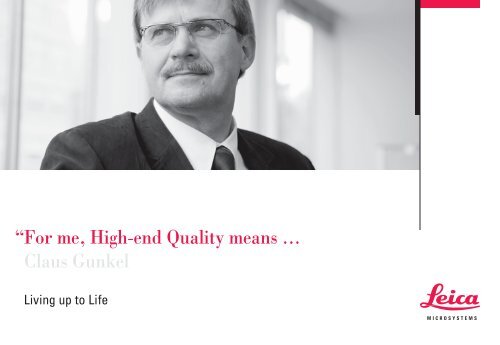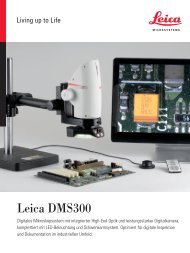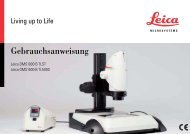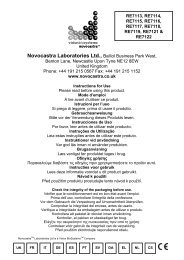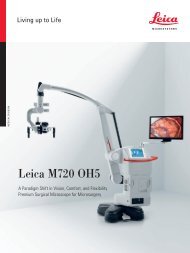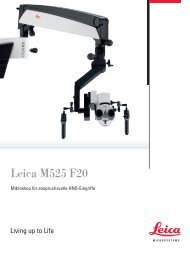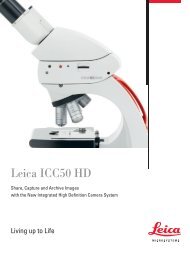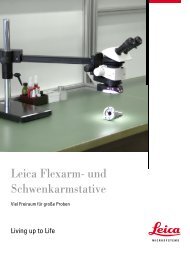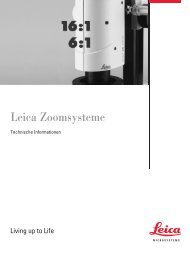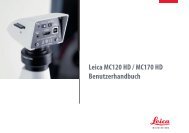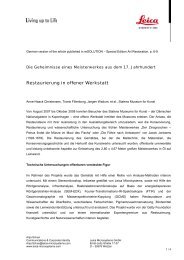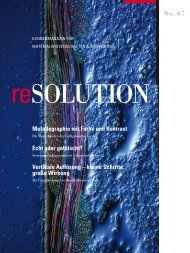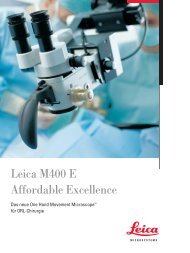For me, High-end Quality means … Claus Gunkel “ - Leica ...
For me, High-end Quality means … Claus Gunkel “ - Leica ...
For me, High-end Quality means … Claus Gunkel “ - Leica ...
You also want an ePaper? Increase the reach of your titles
YUMPU automatically turns print PDFs into web optimized ePapers that Google loves.
<strong>“</strong><br />
<strong>For</strong> <strong>me</strong>, <strong>High</strong>-<strong>end</strong> <strong>Quality</strong> <strong>me</strong>ans <strong>…</strong><br />
<strong>Claus</strong> <strong>Gunkel</strong>
The physicist Dr. <strong>Claus</strong> <strong>Gunkel</strong> was born<br />
on 30 March 1954 and is married. In addition<br />
to his degree in physics, he holds a further<br />
qualifi cation in industrial engineering.<br />
He has nu<strong>me</strong>rous publications to his credit,<br />
as well as more than a dozen issued and<br />
p<strong>end</strong>ing patents.<br />
<strong>…</strong> working with highly motivated and qualified<br />
employees who leave DIN and ISO standards<br />
far behind – day in, day out.”
Dr. <strong>Gunkel</strong>, before we talk about the personal signifi cance that high-<strong>end</strong> quality has for you,<br />
could you briefl y tell us how long you have been with <strong>Leica</strong> Microsystems and the positions<br />
you have held?<br />
Well, a few fi gures are unavoidable when answering that. In January 1985, I started out as the develop<strong>me</strong>nt manager for<br />
thin fi lms and fi lters. In April 1994, I was made production manager for optics. Five years later, I was put in charge of the<br />
Optic Center, assuming responsibility for around 160 com<strong>me</strong>rcial employees, 30 researchers, engineers, technicians and<br />
master crafts<strong>me</strong>n, as well as 17 trainees and students. In 2001, I was also given general com<strong>me</strong>rcial power of attorney.<br />
What exactly does the <strong>Leica</strong> Optic Center do? And did physics, optics and perhaps precision in general already<br />
captivate you as a child? Did you have any early experiences that set the stage for your present position?<br />
Our mission is to provide high-performance optics for microscopes and microscopy systems that <strong>me</strong>et specifi cations and fulfi ll<br />
quality standards, and to do so on ti<strong>me</strong> and at a competitive price. We supply them to our own Life Science Research and Industry<br />
divisions and to external custo<strong>me</strong>rs. We’re also involved in the ongoing develop<strong>me</strong>nt of <strong>Leica</strong>’s optical technology and process<br />
competence at our Wetzlar, Shanghai and Singapore facilities. We not only rely on our own highly qualifi ed people, but also take<br />
advantage of a network of leading international institutes and renowned worldwide enterprises in all of the industries relevant to<br />
us. And with regard to the second part of your question: yes, I’ve always had a soft spot for technology and people – and especially<br />
for develop<strong>me</strong>nt work in a team.
<strong>“</strong><strong>Quality</strong> is never an <strong>end</strong> in itself.”<br />
<strong>High</strong>-<strong>end</strong> quality is not only central to the <strong>Leica</strong> Microsystems identity, it’s probably also<br />
an important factor in your day-to-day work. What does quality <strong>me</strong>an to you? Is it a <strong>me</strong>ans to<br />
an <strong>end</strong> or an <strong>end</strong> in itself?<br />
Attaining quality calls for effective, transparent processes backed by highly qualifi ed and motivated<br />
employees. <strong>Quality</strong> is the result of a process. It’s never an <strong>end</strong> in itself, but the cornerstone of<br />
custo<strong>me</strong>r satisfaction <strong>…</strong> (smiles) and when you succeed, it also contributes to your own satisfaction.
What are decisive quality criteria in your view? Are there important expressions of high-<strong>end</strong> quality<br />
that go beyond purely technical aspects?<br />
In addition to the testing and acceptance conditions and the associated <strong>me</strong>asuring and testing instru<strong>me</strong>nts for individual<br />
products, the entire process from advising the custo<strong>me</strong>r to processing the order, manufacturing the product, delivering it<br />
and setting it up on the custo<strong>me</strong>r’s premises is geared toward high-<strong>end</strong> quality. That said, the process chain is only as<br />
strong as its weakest link.<br />
Unconditional commit<strong>me</strong>nt to maximum quality is integral to the <strong>Leica</strong> vision. Our strategy, which in turn shapes our roadmap,<br />
follows that vision.<br />
The pursuit of high-<strong>end</strong> quality is a common the<strong>me</strong> throughout the <strong>Leica</strong> Microsystems world, and the motivation and<br />
qualifi cations of our employees are central to it. 80% of the <strong>Leica</strong> Optic Center staff consists of skilled workers, and roughly<br />
a quarter of those are certifi ed master crafts<strong>me</strong>n or trained technicians, or have similar advanced qualifi cations. We see<br />
vocational training as an indispensable ele<strong>me</strong>nt of high-<strong>end</strong> quality, and we’ve always provided it, even during economic<br />
downturns. 7.6% of <strong>Leica</strong> Microsystems’ workforce consists of trainees or students. At the <strong>Leica</strong> Optic Center, that share<br />
is one percentage point higher. In addition to traditional vocational training, we’ve also been providing integrated universitylevel<br />
campus and distance education options to qualifi ed employees for several years now. Senior representatives of the<br />
<strong>Leica</strong> Optic Center also chair or participate in testing and ISO committees in their respective fi elds.
How do you assure quality in the competence center? Do you use special instru<strong>me</strong>nts, processes<br />
or guidelines? Which standards serve as your orientation?<br />
Our work is based on transparent processes with unambiguous sequences of process steps perfor<strong>me</strong>d by highly<br />
qualifi ed, motivated staff who can rely on suitable instru<strong>me</strong>nts such as <strong>me</strong>asuring equip<strong>me</strong>nt and guidelines.<br />
We’ve been ISO 9000-certifi ed for nearly one and a half decades, comply with German <strong>me</strong>dical technology laws<br />
and have an environ<strong>me</strong>ntal manage<strong>me</strong>nt system in place.<br />
<strong>Quality</strong> is a property that virtually all companies – especially those in the precision optics and microscopy industry –<br />
claim for their products. What distinguishes high-<strong>end</strong> quality as practiced at <strong>Leica</strong> Microsystems from the more common<br />
understanding of quality?<br />
We have a living quality consciousness – testing and acceptance criteria, internal <strong>me</strong>asuring concepts and inspection<br />
sequences are integrated into our production process. ISO and other international standards are our minimums.<br />
As a rule, we demand more of ourselves and our products. <strong>Leica</strong>’s understanding of quality is not just related to the<br />
individual product, but also to its defi nition and develop<strong>me</strong>nt, and includes the entire custo<strong>me</strong>r-v<strong>end</strong>or relationship.<br />
We not only act as v<strong>end</strong>ors to our custo<strong>me</strong>rs – we also have v<strong>end</strong>ors who we regard as strategic partners and who<br />
share our understanding of quality.
Over one hundred years ago, the stated objective of Ernst Leitz was to be active ‘with the user, for the user’.<br />
In your opinion, what role does high-<strong>end</strong> quality play in living up to that claim?<br />
The Ernst Leitz claim remains as relevant as ever for us as the foundation of a performance-oriented<br />
partnership with our custo<strong>me</strong>rs. And it’s not surprising that it’s echoed in the Danaher dictum, ‘listen to<br />
the Voice of the Custo<strong>me</strong>r’. It’s essential to pay close attention. Only then will high-<strong>end</strong> quality make us<br />
a reliable and competent partner in the quest for new answers.<br />
<strong>“</strong><br />
International standards are<br />
our minimums.”
Optical quantitative determination of structures smaller than 100nm is now possible for the<br />
fi rst ti<strong>me</strong> with the 150x/0.90 248nm AT DUV objective. Thanks to its revolutionary Air Space<br />
Technology, 17 different lenses can be positioned with great accuracy in an objective with a<br />
length of only 42mm. All optical surfaces are fi nished to nano<strong>me</strong>ter precision. The di<strong>me</strong>nsions<br />
of the <strong>me</strong>chanical components of the objectives are also built to di<strong>me</strong>nsions within a fraction<br />
of a human hair – literally razor-sharp tolerances.<br />
<strong>“</strong><br />
‘Made in Germany’<br />
has kept its<br />
powerful aura.”
A number of <strong>Leica</strong> Microsystems’ competitors are at ho<strong>me</strong> in Asia. Have you observed any<br />
cultural differences between European and Asian companies in their understanding of what<br />
constitutes quality?<br />
‘Made in Germany’ has kept its powerful aura and <strong>Leica</strong> is an exceptionally valuable brand. I suspect that we<br />
so<strong>me</strong>ti<strong>me</strong>s aren’t aware of its true significance. After all, I’ve experienced great respect, bordering on reverence,<br />
for both brands – especially in Asia.<br />
<strong>Leica</strong> Microsystems sees itself as a worldwide company that gives people from many different cultural backgrounds<br />
space and infl uence at all levels. We work according to our own <strong>me</strong>thods and processes and our employees around<br />
the world share a common quality consciousness.<br />
Our competitors are, at best, companies with international reach in which managers from their respective ho<strong>me</strong><br />
countries hold dominant positions in the foreign branches. Those managers often stifl e the global diversity that can<br />
lead to new ideas and a deeper understanding of regional markets.<br />
I’m also confi dent that individuals at <strong>Leica</strong> Microsystems have greater freedom to make decisions and less need<br />
for consensus in business-related matters than in other corporate cultures.
Coming back to you personally, what are your next projects? What are your goals and where<br />
do you personally see a need for action? Where is your journey going?<br />
Improved optics for STED and electrophysiology are at the top of the list. That will help us work toward a deeper<br />
understanding of the processes within human cells. Understanding the causes of diseases, identifying them<br />
earlier and thus being able to provide ti<strong>me</strong>ly, effective re<strong>me</strong>dies is a noble goal. My team <strong>me</strong>mbers and I derive<br />
great satisfaction from working at the leading edge of the fi ght against dangerous diseases.<br />
From the business angle, our focus is on continuously improving our processes. It’s essential that we strengthen<br />
steps that lead to greater custo<strong>me</strong>r benefi t and eliminate wasteful ones that do not lead to the creation of value.<br />
With our DBS tools, we have the resources we need to systematically unlock our potential.<br />
Technologically, we int<strong>end</strong> to remain the market leader and we’re working toward consolidating that position in<br />
optics. Together with our strategic partners and R&D, we’re currently evaluating new processes that we will be<br />
applying in Wetzlar and other <strong>Leica</strong> Microsystems locations.
You seem to invest all of your energy into maintaining the best<br />
possible, consistent quality. Do you still have ti<strong>me</strong> for a personal<br />
life? Do you have any hobbies? How do you relax, and where?<br />
Most of my ti<strong>me</strong> and energies are devoted to my work. But I fi nd that<br />
fulfi lling professional challenges also have an invigorating effect on my<br />
personal life. My relative shortage of free ti<strong>me</strong> <strong>me</strong>ans that I experience<br />
it with greater intensity than I otherwise might.<br />
My hobbies include alpine skiing and sp<strong>end</strong>ing ti<strong>me</strong> outdoors with a<br />
tent and sleeping bag in the sum<strong>me</strong>r. I also own a farmyard which is<br />
over 250 years old and has been placed under an historical preservation<br />
order. (smiles) And it’s going to be a while before I have it up<br />
to ‘<strong>High</strong>-<strong>end</strong> <strong>Quality</strong>’ standards <strong>…</strong>


